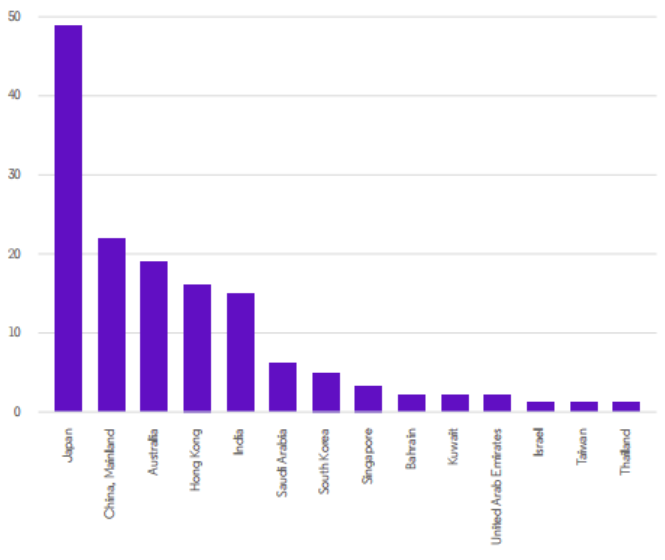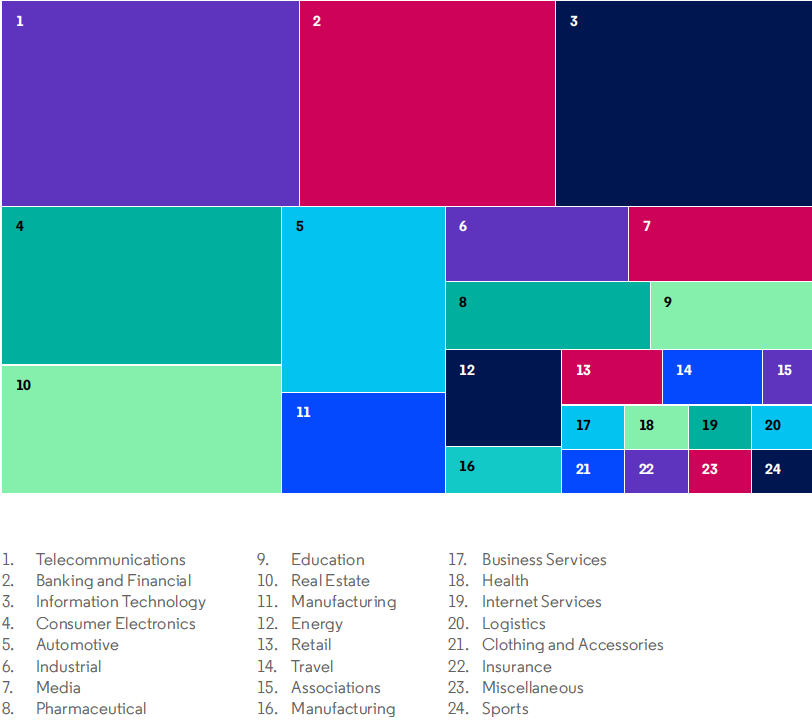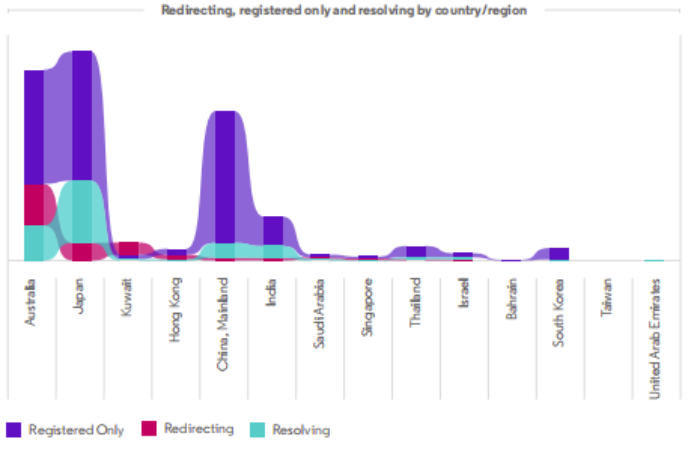In 2012, when the Internet Corporation for Assigned Names and Numbers (ICANN) launched its application round for new gTLDs, 1,154 applicants from every continent across the globe filed applications to operate new gTLDs. Interestingly, many brand owners also seized the opportunity to apply for their own .BRAND TLDs (for example, .MARRIOTT, .BMW, and .SONY) in order to create their own internet real estate and promote and protect their online identity.
In the Asia-Pacific (APAC) region of the world, 105 companies applied for .BRAND TLDs with some companies applying for more than one. A total of 144 .BRAND TLDs were applied for by companies in Asia-Pacific. This count makes up 25.5% of the total .BRAND TLD applications (565) filed in 2012.1
Usage of a .BRAND TLD
A .BRAND TLD provides brand owners with the ability to control all content and use of a name space to the right of the ’dot.’ With a .BRAND TLD, brand owners can drive internet traffic to websites and relay information with very short and memorable domains and also save themselves trouble from managing domains under other generic TLDs. A .BRAND domain name can be used to:
- redirect traffic to an existing home page;
- build a microsite;
- launch new products;
- allocate brand SLDs to subsidiaries/branches as their website;
- support marketing activities;
- deliver a themed program; and
- create a new home page.
Big companies, Big .BRANDs
Among the 105 APAC applicants that filed for .BRAND TLDs, 38 belong to Fortune 500 companies2 such as Nissan, Samsung and Toyota. A complete breakdown of these applications is shown in the table below.3 Other notable companies that applied for a .BRAND include Seiko, Nikon, ShangriLa and Baidu.
| Organization | No. of brand TLDs | Country/region | TLDs |
|---|---|---|---|
| Alibaba | 4 | China, Mainland | .alibaba; .alipay; .taobao; .tmall |
| NISSAN | 3 | Japan | .datsun; .infiniti; .nissan |
| Bridgestone Corporation | 2 | Japan | .bridgestone; .firestone |
| China United Network Communications Corporation Limited | 2 | China, Mainland | .unicom; .联通 |
| CITIC Group Corporation | 2 | China, Mainland | .citic; .中信 |
| Industrial and Commercial Bank of China | 2 | China, Mainland | .icbc; .工行4 |
| SAMSUNG SDS Co., LTD | 2 | South Korea | .samsung; .삼성 |
| Toyota Motor Corporation | 2 | Japan | .lexus; .toyota |
| Canon Inc. | 1 | Japan | .canon |
| Fujitsu Limited | 1 | Japan | .fujitsu |
| Hitachi | 1 | Japan | .hitachi |
| Honda Motor Co., Ltd. | 1 | Japan | .honda |
| Hyundai Motor Company | 1 | South Korea | .hyundai |
| KDDI | 1 | Japan | .kddi |
| KIA Motors Corporation | 1 | South Korea | .kia |
| Mitsubishi | 1 | Japan | .mitsubishi |
| Mitsubishi Tanabe Pharma Corporation | 1 | Japan | .mtpc |
| NEC Corporation | 1 | Japan | .nec |
| NIPPON Telegraph and Telephone Company | 1 | Japan | .ntt |
| Panasonic Corporation | 1 | Japan | .panasonic |
| Reliance Industries Limited | 1 | India | .reliance |
| Softbank Corp. | 1 | Japan | .softbank |
| Sony Computer Entertainment Inc. | 1 | Japan | .playstation |
| Sony Corporation | 1 | Japan | .sony |
| State Bank of India | 1 | India | .statebank |
| Suzuki Motor Corporation | 1 | Japan | .suzuki |
| Tata Motors Ltd | 1 | India | .tatamotors |
| TOSHIBA Corporation | 1 | Japan | .toshiba |
APAC .BRAND TLD Distribution
Applicants from Japan filed the most .BRAND TLD applications among all APAC countries/regions with 49. Mainland Chinese companies followed with 22, and Australian applicants filed for 19.4 This is partly explained by the industry sector of the Fortune 500 companies from each region on the list. Although Mainland China has more companies listed on the Fortune 500 than Japan, fewer companies in China applied for a .BRAND because most are manufacturing companies that do not depend heavily on an online presence in order to drive business. More Japanese companies on the Fortune 500 are technology and consumer goods focused, sectors which tend to understand better the importance of online brand presence and awareness and therefore would be more aware of the value of having a .BRAND.
Figure 1: .BRAND TLD Distribution

Source: MarkMonitor
Industry segmentation made up more than half of the .BRAND TLDs and spanned a variety of industry sectors including telecommunications, information technology, banking and financial and consumer electronics. It not surprising that the IT and the banking and financial sectors were a major focus, as these industries are often the target of abuse and domain name infringement and they have multiple portals to interact with internet users.
Figure 2: .BRAND industry segmentation

Source: MarkMonitor
Launching a .Brand TLD
The first launched .BRAND TLDs were .citic and .中信, in 2014 soon after they were delegated. As of the end of 2019, 86 of the 144 .BRAND TLDs had launched. Half of APAC’s .BRAND TLDs were launched in 2015, 2016 and 2017.5
Figure 3: .BRAND launch status

Source: MarkMonitor
Figure 4: Website resolution

In the table below, you can see the top down ranking of resolving, redirecting and registered only domain volume in 14 countries and regions in APAC.6
| Country/region | Resolving domains | Redirecting domains | Registered only domains |
|---|---|---|---|
| Australia | 101 | 120 | 329 |
| Bahrain | 0 | 0 | 2 |
| China, Mainland | 43 | 8 | 380 |
| Hong Kong | 3 | 14 | 17 |
| India | 35 | 7 | 85 |
| Israel | 6 | 3 | 12 |
| Japan | 179 | 51 | 373 |
| South Korea | 3 | 0 | 33 |
| Kuwait | 4 | 35 | 13 |
| Saudi Arabia | 4 | 5 | 8 |
| Singapore | 1 | 5 | 5 |
| Taiwan | 0 | 0 | 0 |
| Thailand | 5 | 4 | 33 |
| United Arab Emirates | 1 | 0 | 0 |
| Total | 385 | 252 | 1,290 |
Challenges to .BRAND Operation
As seen in the table above, there are 1,927 second level domains registered under APAC .BRAND TLDs, but only 637 active domain names that resolve or redirect and that are actively in use. The percentage is only 33%, while the global number is 65.6% (total registration is 19,550 while 12,833 domain names are resolving or redirecting).
Why aren’t more companies using their .BRAND TLDs? The reasons are many.
First, many companies are concerned they might lose traffic if they switch from their current domain name (most likely a .COM or .CN) to a .BRAND. A second reason is that the new gTLDs strings are not well recognized or supported by browsers. Sometimes a domain name with a new gTLD cannot be opened and causes a bad user experience.
In addition, operational policies for a .BRAND take planning and effort to develop and many companies don’t have resources to commit to this effort. As companies have unique business models, organizational structures and product features, there is no single universal .BRAND usage pattern for brand owners to refer to. It is very challenging for brand owners to develop operational policies and procedures due to lack of proficiency and resources.
A fourth reason for the lack of usage can be an absence of communication within the brand company. For example, the technical or marketing team may not know that they have a .BRAND TLD to make use of. If anyone needs to apply for a domain name under a .BRAND, the internal process can be difficult.
Finally, some brands just want to wait and see how others are using their .BRAND TLDs and learn from their successes or failures. The learning curve is steep and brand owners are generally cautious. The more .BRANDS they see in the marketplace, the more inclined they may be to launch their own.
Looking Ahead
.BRAND TLDs provide brand owners the opportunity to use their brand names as their top-level domain and manage the internet space under it. Based on the current status of how .BRAND TLDs are used, there is still work to be done in socializing domain knowledge and engaging .BRAND TLD operators in industry discussions. As time goes on, we will see more and more .BRAND TLDs come online and serve brand owners better.
Although some brand owners took the initiative and applied for their brand TLDs in 2012, there are many companies that missed this opportunity and must wait for the next round of new gTLD applications to open, expected sometime in 2022. In the meantime, brands will benchmark against their peers and the pioneers in .BRAND TLD usage. Because the first round of new gTLDs covered a lot of generic and short words, the number of .BRAND applications in the next round is expected to surpass the number of generic TLDs.
References
- https://statshub.makeway.world/brand-detail-table.php
- https://fortune.com/fortune500/
- https://gtldresult.icann.org/applicationstatus/viewstatus
- 工行 was deleted on April 1st, 2020 based on IANA whois https://www.iana.org/whois?q=xn--estv75g.
- https://newgtlds.icann.org/en/program-status/sunrise-claims-periods
- https://newgtlds.icann.org/en/program-status/sunrise-claims-periods
- https://statshub.makeway.world/brand-detail-table.php


